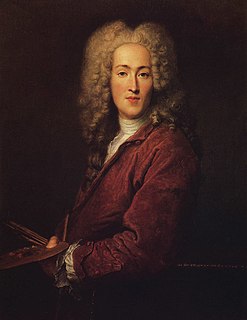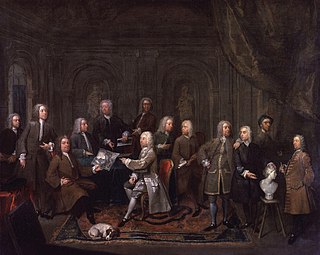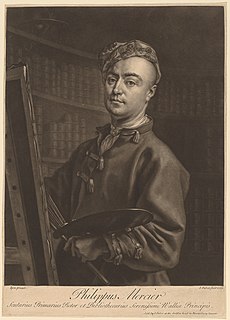
Thomas Gibson (born London, c. 1680; died London, 28 April 1751) was an English portrait painter and copyist, notable as master of George Vertue.

Thomas Gibson (born London, c. 1680; died London, 28 April 1751) was an English portrait painter and copyist, notable as master of George Vertue.
Nothing known of Gibson's life before c. 1711, when he was already established as portrait painter, appointed a founding director of Godfrey Kneller's Academy in London at Great Queen Street. According to the painter Thomas Highmore, Sir James Thornhill applied to Gibson to sketch for him in his large pictures figures in action. among his pupils there was George Vertue. Gibson's sitters included a number of important public figures: Dr Henry Sacheverell (1710; Oxford, Magdalen Coll.), John Flamsteed (1712; Oxford, Bodleian Lib.), Sir Robert Walpole (untraced; engr. G. Bockman), Archbishop William Wake (Oxford, Christ Church Pict. Gal.) and Archbishop John Potter (London, Lambeth Pal.). His most constant patron was John Poulett, 1st Earl Poulett (1663–1743), who commissioned a great number of originals and copies.
Gibson's career was interrupted in 1729-31 by serious illness, and he was obliged to sell his collection and for a time retire to Oxford. After resuming his practice he was patronized by Augusta, Princess of Wales, who in 1742 commissioned a group portrait of her four children, as well as her own portrait (both British Royal Col.). [1]

George Vertue was an English engraver and antiquary, whose notebooks on British art of the first half of the 18th century are a valuable source for the period.

Louis Laguerre was a French decorative painter mainly working in England.

Francesco Bartolozzi was an Italian engraver, whose most productive period was spent in London. He is noted for popularizing the "crayon" method of engraving.

Nicolas Lancret was a French painter. Born in Paris, he was a brilliant depicter of light comedy which reflected the tastes and manners of French society during the regency of the Duke of Orleans and, later, early reign of King Louis XV.

John Smibert was a Scottish-born painter, regarded as the first academically trained artist to live and work regularly in British America.

Jean-Baptiste Santerre was a French painter and draughtsman of the Style Louis XIV, known for his history paintings, portraits, and portrait-like genre subjects. Considerably influenced by Italian masters of the Bolognese school as well as his French contemporaries, Santerre nonetheless made an original contribution in his art, being among the first French painters to bring Netherlandish influences.

Peter Pelham, an American portrait painter and engraver, born in England, a son of a man named "gentleman" in his will. His father, who died in Chichester, Sussex, in 1756, is revealed in letters to his son in America as a man of some property.

Hubert-François Bourguignon, commonly known as Gravelot, was a French engraver, a famous book illustrator, designer and drawing-master. Born in Paris, he emigrated to London in 1732, where he quickly became a central figure in the introduction of the Rococo style in British design, which was disseminated from London in this period, through the media of book illustrations and engraved designs as well as by the examples of luxury goods in the "French taste" brought down from London to provincial towns and country houses.

Gawen Hamilton, easily confused with the later, more prominent artist Gavin Hamilton, was a Scottish painter working in London, a member of the Rose and Crown Club. He was one of the first wave of British born painters of 'conversation pieces' along with contemporaries such as William Hogarth and Charles Philips. These are works that depict groups of friends, families and acquaintances often engaging in a variety of genteel activities such as playing cards or taking tea. Some of Hamilton's pieces depict gatherings of artists and craftsmen such as the Rose and Crown Club itself.

The Rose and Crown Club was a club for artists, collectors and connoisseurs of art in early 18th-century London, England.

Philippe Mercier was an artist of French Huguenot descent from the German realm of Brandenburg-Prussia, usually defined to French school. Active in England for most part of his lifetime, Mercier is considered one of the first practitioners of the Rococo style, and is credited for influencing a new generation of 18th-century English artists.
Johan Faber, anglicized as John Faber, commonly referred to as John Faber the Elder, was a Dutch miniaturist and portrait engraver active in London, where he set up a shop for producing and marketing his own work. His son John Faber Jr. was also active in this field.

Thomas Goff Lupton was an English mezzotint engraver and artist, who engraved many works by J. M. W. Turner and other notable British painters of the 19th century. He also produced some pastels, exhibited at the Royal Academy. He played an important part in advancing the technical aspect of engraving by introducing soft steel plates.
Gerhard Bockman (1686–1773) was a Dutch portrait painter and mezzotint engraver.
Claude Du Bosc was a French engraver, publisher, and printseller who spent much of his career in London. Associated with the pioneering French Rococo artist Antoine Watteau, Du Bosc belonged to the first wave of skilled engravers to arrive in London during the early 18th century, notably contributing to English printmaking and publishing of that era, along with a younger contemporary Hubert-François Gravelot.
Louis Du Guernier (1677–1716), also anglicized as Lewis Du Guernier, was a Franco-English engraver.

John Smith was an English mezzotint engraver and print seller. Closely associated with the portrait painter Godfrey Kneller, Smith was one of leading exponents of the mezzotint medium during the late 17th and early 18th centuries, and was regarded among first English-born artists to receive international recognition, along the younger painter William Hogarth.
Jean Simon, anglicized as John Simon was an English mezzotint engraver and print publisher of French Huguenot birth, particularly known for his portraits. Notably associated with the German-born portrait painter Godfrey Kneller, Simon had an active career that spanned at least three and a half decades, and was regarded as one of the mezzotint medium's most prolific masters of his generation, along with the older contemporaneous engraver John Smith.

Charles d'Agar (1669–1723), was a French painter.
Edmund Lilly was an English painter, most notable for his portraits.
| Wikimedia Commons has media related to Thomas Gibson (artist) . |